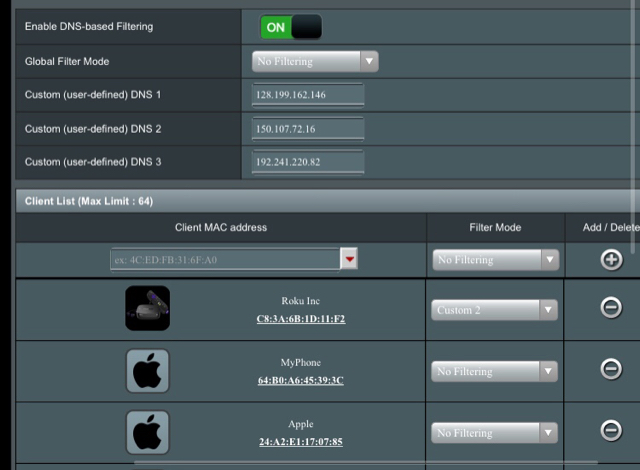Michael, welcome. This may be the exact answer for your post, but anything is possible. Had a bit of extra time today, so hope this points you where you want/need to be.
If your Roku is close enough to your router for Ethernet, you'd have greater speed/bandwidth with less buffering of HD and/or 4K, especially if the Roku device is set to use 2.4 wireless. Video streaming often severely impacts not only your viewing pleasure but slows performance of your other 2.4 devices to a crawl, depending on amount of bandwidth you have. You're correct in assuming almost any problem posed has been answered many times, many ways so if you use the search function you can usually find what you need. Sometimes it's difficult to find answers so here's a few pointers. First, take snapshots so you can refer back if you become unsure what changes you made and/or saved.
Go to the WAN tab/section in the router GUI, and choose if you wish to allow the router to automatically go 'straight' to the internet (WAN/ISP), which is your ISP. You can use the ISP's choice of DNS, or set the 'automatically choose' button to 'no' so you can choose any other DNS solution you like. These days, the ISP's DNS may not be as private or as fast as you like, and they can now sell your information as they see fit, so do your research. DO use a primary and secondary DNS, either here or on your LAN DHCP Server page, preferably from different servers in case the primary ever goes down. Example; #1 DNS could be google, 8.8.8.8, then QuadNine, 9.9.9.9 or even 1.1.1.1. These are good, fast public DNS servers; some say they don't log your searches and don't keep records very long; it's up to you to check privacy policies, and to be able to see and go where you choose.
This reply assumes you've set the device names/SSID scheme as you wrote for your 2.4 band, but remember, there's only one 2.4 band (not going into or counting 'guest' bands). We use a single SSID for all of the bands, even though we don't have much use for 2.4 these days. If you haven't read the posts, an unknown bug causes problems with the 2.4 band on some RT-AC3200s, with no fix on the horizon. The bug affects some more than others but we haven't had any problems. Try to keep your SSIDs as simple as possible and change your passwords at least once a month; don't use short easy (dumb) passwords, but for now, stay away from exotic characters.
Proceed to the LAN DCHP Server section. Since the router sees the MAC address of every device, regardless whether it's connected by wire or wireless, instead of using different SSIDs to route your devices to OpenVPN clients or WAN/ISP, (if that is the idea), the LAN DHCP section can assist you in sending/routing your devices to WAN/ISP (DNS) or to your OpenVPN client; the OpenVPN client will use whatever the VPN provider has coded into their config.
IF you hover over and/or click on BOLD items or sections, information or a link to a page may appear to help you. Here's a link to get you started:
https://www.asus.com/support/FAQ/1000906
When the top portion of the LAN DHCP page is set up, save the page and move down to 'Manual Assignment; on this you can choose YES but if you choose 'no' the rest of this may not help you very much. You'll be down to the 'Manually Assigned IP around the DHCP list (Max Limit : 128) section, which will list all devices by their MAC address. Use the MAC address pull-down menu to choose each device; give each device a 'friendly' hostname, such as MikeiPad, AlicePC, instead of trying to remember every MAC addresses. After doing so, the router makes it easy for you to see and select your devices. Add each device in this section to the setup using the plus ( + ) symbol on the right of the page, you can remove them using the minus ( - ) symbol. Save the page.
Now go to the VPN Client tab/section, to set up and load your Nord OpenVPN client. Choose whether you want to turn the VPN client on manually or have it start with the router. You can name each client as you please, i.e., Nord1, etc. Check all settings then save the page. At this point, make sure you've taken a screen shot of each page you configured, then save the entire router setup before you reboot the router. You don't have to reboot, but over the years, we've found that starting everything fresh by rebooting works well. It can take several minutes to load so grab a beverage, etc. If for some reason the bands/SSIDs or devices don't work as expected, have your screen grabs ready to refer to for troubleshooting.
Nord used to provide a tutorial for setting up Asus/Merlin, but it may not be up to date for the latest version. Remember, the search function in the forums and the wiki are your best friend. Keep your search terms basic/simple and you'll eventually find what you need, and be patient. This is a basic way to set up your SSIDs, devices, alternate DNS and OpenVPN config from scratch, it can be as simple, yet as complicated you want. Good luck.

